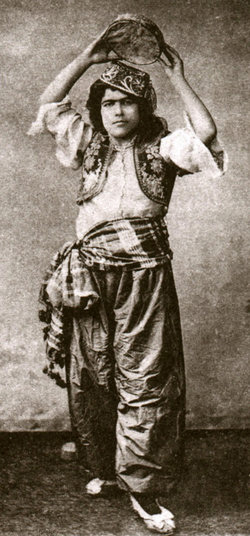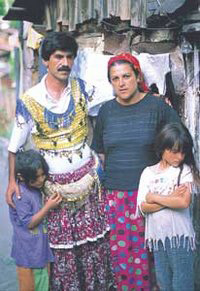Sevdah's tambourines, which will be used in Bil-bil čoček |
Bil-bil Čoček
Sevdah became beloved among its audiences especially through its Anteria dance, which we succeeded to save from oblivion with the help of ethnographic notes by the respected Bosnian folklorist, Hajrudin Hadžić Hadžija. A very few people know that this Bosniak city dance by its rhythm and consequently steps belongs to the group of čočeks. Sevdah liked the demanding rhythm of the Anteria dance so much that it decided to face the challenge and prepare another čoček for its audience. However, which one? Thus, our choreographer, Denis Bašić, started his search for another čoček.
In regard to music, the decision was easily and quickly made to use the sevdalinka Mene majka jednu ima (I am the only daughter of my mother) in the brilliant interpretation of Amira Medunjanin accompanied by the already legendary band Mostar Sevdah Reunion to whose music Sevdah also dances its Anteria dance.
Köçek with tambourine - late 19th century
(photo taken over from Wikipedia)
The next step was to find more details about the steps of the Bosnian čočeks and čočeks in general. The research led us to Anatolia and even further away to Persia. The Balkan Slavic word, as well as the dance, čoček, according to all available data, seems to stem from Istanbul and Anatolia. In the Turkish language this dance is called köçekçe (ç = ch) and the dancer who dances it is called köçek. The term köçek originally comes from the Persian language [Persian kuchak; Turkish küçük - little or small (boy)] and signifies a young teen-age dancer, usually dressed as a girl, who served as an entertainer, but also as a sexual worker. A very interesting article on this topic can be found here. However, please, keep in mind that Sevdah does not agree with everything that is said in this article.
Alongside the cited article we owe to the reader a reminder that the male entertainers (köçekçeler), who in different entertainment programs danced female roles, are not any more “one of the most significant symbols of Ottoman Empire culture,” as it is stated in this Wikipedia’s article, than the European actors and ballet dancers dressed as women are one of the most significant symbols of Christian European culture. From the times of ancient Greece, to Shakespeare’s theater, and even later, men in Europe, too, played female theater roles and the same was the case with early European ballet ensembles. Simply, due to the religious, moral, and ethical codices of the given times, it was not considered appropriate for women to perform publicly.
A köçekçe dancer in female garb
Anatolia, Turkey, 20th century
(photo taken over from Wikipedia)Equally, it is a big question whether köçekçeler, the male entertainer in the Ottoman Empire, were “usually” non-Muslims as it is stated in this article in Wikipedia. The very fact mentioned in this same article that even nowadays in some parts of Turkey men dance female roles as a part of “folkloric” art tells us that this kind of dance must have been widespread among Muslims, too.
Again, there is nothing unusual when Anatolian Muslim men dance dressed like women. Similar phenomena can be found all around the world and most probably could represent the remnants of Pagan culture. Thus, for instance, during the Istrian (Croatian) carnivals men are dressed like women and in their dances and games with other men who are dressed like men they even simulate sexual intercourse. Unconsciously, following some ancient Pagan traditions, in this way the masked Istrians want to wish to their hosts a fertile and fruitful year.
In any case, the majority of ethnologists and art historians agree that the music of čoček could have originally penetrated deeper into the Balkans in the early 19th century with the Ottoman military orchestras. Through generations, the čoček music, as well as the dance were preserved predominantly thank to the Balkan Roma. Thus, the čoček came to Bosnia, too, with the Ottoman military orchestras and was preserved primarily by the local Roma. Since the Bosnian Roma population has historically been much smaller than the Roma population of Southern Serbia and Macedonia, this dance has not been as easy to encounter in Bosnia as it has been the case with these two other provinces of the former Ottoman Empire.
Today we live in a different time and Sevdah has a lot of talented girls, so that our guys will not have to dance female roles in Sevdah’s čoček. Sevdah diligently works on this new dance bringing into it a lot of the fire and charm of Roma dancing style. As mentioned before, Sevdah will dance its new čoček on the famous sevdalinka Mene majka jednu ima (I am the only daughter of my mother). We named this new čoček of ours Bil-bil čoček (in Bosnian bi’ l’ means “should I”), because the girl in the song, as well as in our choreography, is continuously asking herself whether she should marry whom her mother has chosen for her or whom her heart wants. If you would like to learn whom the girl finally marries, you will have to come to one of Sevdah’s performances of this dance.
We hope that our Bil-bil čoček will be ready for the stage in the near future and that the audience will enjoy watching it as much as we enjoy preparing it.

